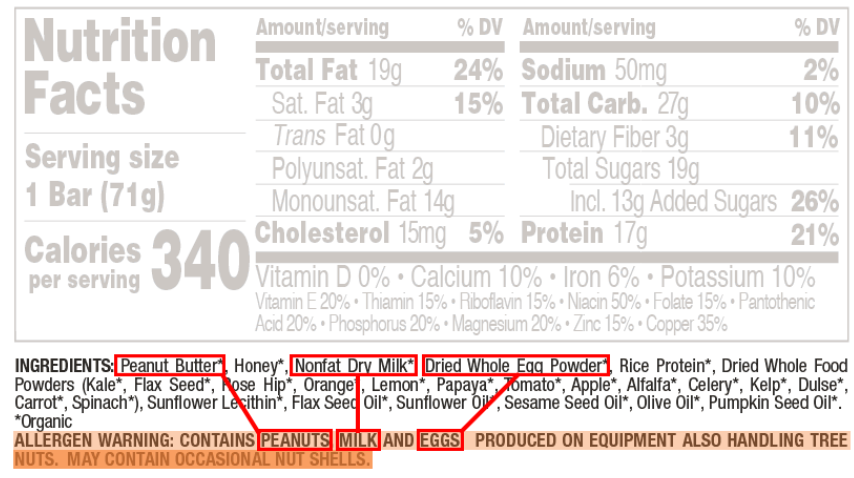Food Labels: An Effective Way To Put People To Sleep
For the Foodies (the allergy foodies)
If you are wrestling with food allergy, eczema, maybe an intolerance of some sort, then clearly food selection is important. And, boy, do you have your job cut out for you. If you think you had decision fatigue or paralysis by analysis, pull up a chair, we’ll get you a cup of tea. You’re in good company!
This article is really going to be about managing food choice. But specifically, if you choose to purchase food in a box or packaging, how to investigate the label and make informed choices. In the short term, the best way to prevent an allergic explosion is to avoid the lighting the fuse.
Context Around Labeling Standards
In 2006, a law went into effect to ensure clearer labeling around allergenic food ingredients for us allergy folk. It was called the Food Allergen Labeling and Consumer Protection Act (FALCPA).
Great! Any food regulated by the FDA gets this new level of scrutiny. No where to hide now, allergen BAFFOONS!
The 8 major allergens are:
milk
egg
fish
crustacean shell fish
tree nuts
wheat
peanuts
soybeans
This law also requires additional information on the food label regarding:
specific nut (e.g. almond, pecan, walnut, etc)
specific fish (e.g. bass, flounder, Pollack)
specific crustacean shellfish (e.g. lobster, shrimp, crab)
All in all the FALCPA works on these FDA regulated products:
packaged foods
conventional foods
vitamins and dietary supplements
infant formula and infant foods
medical foods
The FALCPA Savior hath cometh! But, for the sake of being thorough… what ISN’T covered in the language here around labeling allergens? Hmmmmmm? Great question, let’s discuss.
There are many entries in this list (go here for more) but I will stick to the food varieties. First, any food products regulated by the USDA which includes meat, poultry, and certain egg products, are not covered. Second, any product regulated by the Alcohol, Tobacco Tax and Trade Bureau is not covered. These include alcoholic drinks, spirits, beer, and tobacco products. And, here is the big one:
any restaurant foods or foods placed in a wrapper or container in response to a person’s order for that food. This includes, street vendors, festival foods, and fast food restaurants.
That’s like …. so many meals everyone who eats or has eaten since 2006.
just to be extra clear, any restaurant foods you eat are not covered by the law that requires essential food allergen labeling
FALCPA and the term “non-dairy.”
Kidswithfoodallergies.com talks about the use of terms and their limits of use. The term “non-dairy” still continues to appear on foods containing caseinates (milk-derivatives) as ingredients. While the caseinates will be listed in the ingredients list, the stinking term “non-dairy” could still be used, resulting in a false sense of confidence.
Same with gluten.
As of 2013, the FDA issued a ruling that strictly defines what can be standardized as gluten free. In case you’re wondering is 20ppm (parts per million) but some foods have no way of testing for this standard. They include hydrolyzed and fermented foods.
Advisory Statements like “May contain.”
FALCPA does not require these statements. It’s completely voluntary. Kudos to the companies who do offer this advisory warning. So what does it mean though. Well. There could be cross contact of allergens you don’t want to consume. It’s a risk management game.
I won’t go through every single ingredient that could pose a problem for someone but the theme to take away is that there are caveats to ingredients lists and the reporting of allergenic compounds on labels. Be prepared to pull out your microscope on these labels. So, again, the final message is, be careful and if possible, reduce your need for these packaged products where possible.
Anatomy of a Nutrition Label
At some point you’re going to have to do it; take a sweet look at the ingredients of a food product that is, otherwise, indistinguishable from any actual food. I invite everyone, when possible, to strive to buy single ingredient items, otherwise known as, actual food.
All I’ll say is that, if the food is a single ingredient food, there is no label. You can curate your own foods that match your needs. This is “the way”, the gold standard
Fine Print
This is an easy statement to write. It doesn’t take into account food desertion, low time availability, and all the other variables that make packaged food enticing and convenient. I want to acknowledge not everyone has access. These are aspects that hopefully I can talk about in future posts.
With that said, let us proceed!
In the nutrition facts, according to the FDA’s site there’s serving information, the number of calories, the nutrients, and built in is a quick guide percentage of daily value. But for this, we are after the ingredients.
This is a label I pulled from one of my favorite protein bars, Perfect Bar. I get nothing from these guys except, delicious, unadulterated calories. But, I cannot eat their peanut butter bar anymore because I’ve developed an intolerance. Regardless, what you see in this ingredients list is what you’d expect:
peanut butter
milk
eggs
Now, they list the allergen source IN the ingredients. This is one of two ways to identify the source of the allergen according to the FDA. But, they also have an allergen warning, stating again, that there are indeed allergens present.
Secondly, this label has a “Contains:” statement. This is the second option for manufacturer’s to communicate that a product has allergenic landmines. What’s cool about this Perfect Bar label is that they have provided both methods for communicating allergens. Some labels may only have one of these options and no voluntary advisory statements. It’s sort of a mixed bag out there. Finally, companies are encouraged to add additional warnings around cross contamination. While encouraged, this is not mandatory. The Perfect Bar label does this, so, great job!
“May Contain” advisory statements are there to be helpful but annoying as well. They propose risk. It can’t really tell you yes or no … just … MAYBE. And in the case of my child’s health, maybe, doesn’t feel great. So weigh your options wisely.
Even here, for this pack of freeze dried blueberries, there are no “major 8” allergens present. But the company provides that advisory statement. While we are gracious, you’re left to decide what to take away. What is the risk at this point?
It’s hard to tell. The likelihood you’ll find cross contamination might be slim. It also depends on how sensitive you are to that allergen, in this case, milk or soy.
I’ve read your words, sooo what’s the call to action?
In a sense, there is no call to action. You are already doing the action. However, this information will hopefully sharpen those selection skills if you are the food buyer and preparer for your family. We’ve all heard it before, “An ounce of prevention is worth a pound of cure.”
Thanks Ben.
But in this context, prevention is knowing.
Knowing what?
Knowing where your food has been, what it might have been in contact with, and what a technically named ingredient translates to in layman’s terms. Keep feeding your families. Do it with this newly acquired mindfulness. Simple acknowledgements like this could be a very low hanging fruit for the sake of prevention.
Stay safe and healthy friends!




